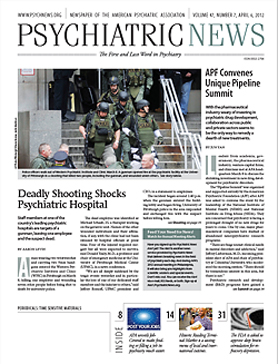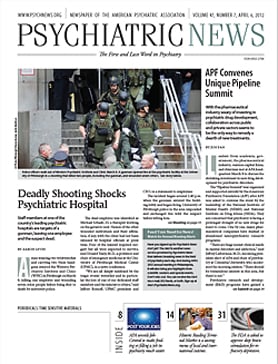“I was just doing my job,” the policeman, soldier, or emergency first-responder will typically say describing the cool aplomb with which such individuals respond to events that might in other less trained individuals evoke emotions of profound shock, terror, and helplessness.
And yet later the same individuals may develop symptoms of posttraumatic stress disorder (PTSD) that may not be seen in those who experienced more intense reactions at the time of the event.
And that’s one reason why a work group on trauma and stressor-related disorders is proposing to drop the criterion for PTSD, currently included in DSM-IV, requiring individuals to have subjectively experienced fear, helplessness, or horror at the time of a traumatic event.
“Different people respond to traumatic events in different ways,” Matthew Friedman, M.D., the work group chair, told Psychiatric News. “We had thought PTSD required this intense emotional reaction at the time of an adverse event, but research and clinical experience have shown that the criterion was not at all useful in predicting who would or would not subsequently exhibit symptoms of PTSD.”
Friedman said that the proposed elimination of this criterion is supported by several lines of research including a large World Health Organization study titled “The Role of Criterion A2 in the DSM-IV Diagnosis of Posttraumatic Stress Disorder,” published in Biological Psychiatry in September 2010.
He added that clinical experience has shown that the criterion tended to exclude people for whom exposure to a traumatic event was an occupational hazard for which they had been extensively trained. “Very frequently people would say, ‘I didn’t have any emotional response at all; I was doing my job.’
“So it was their training that kicked in at the time, and it ruled out a lot of people,” Friedman said. He is director of the Department of Veterans Affairs National Center for Post-Traumatic Stress Disorder and a professor of psychiatry and of pharmacology and toxicology at Dartmouth Medical School.
Friedman noted that more generally, PTSD in DSM-5 may no longer be narrowly considered a fear- and anxiety-based disorder but is being reconceptualized to include a wider spectrum of negative responses to adverse events including anhedonia-like and externalizing symptoms. “With this new conceptualization, the criterion describing subjective experience at the time of the event ceases to have as much importance,” he said.
The elimination of the requirement for a subjective negative response at the time of a traumatic event is one proposed change among several that include removing PTSD from the anxiety disorders and putting it in a chapter with other disorders that arise in response to adverse events that precede the emergence of symptoms; the addition of new symptoms, as well as a new symptom cluster; and inclusion of two new PTSD subtypes.
Friedman also outlined for Psychiatric News changes to criteria for acute stress disorder and for adjustment disorders, both now classified as trauma- and stressor-related disorders (see Acute Stress Disorder Changes Proposed). Friedman’s work group is a subgroup of the Anxiety, Obsessive-Compulsive Spectrum, Posttraumatic, and Dissociative Disorders Work Group reviewing criteria for more than 30 disorders.
In addition to the elimination of the criterion requiring intense fear, helplessness, or horror at the time of the adverse event, a new symptom cluster may be added. Friedman explained that in DSM-IV, PTSD is defined by three symptom clusters: re-experiencing symptoms, avoidance and numbing symptoms, and arousal symptoms.
But he said that based on much recent research, the work group is proposing for DSM-5 that avoidance and numbing symptoms be broken out separately, with numbing symptoms being renamed as a fourth symptom cluster to be called “negative alterations in cognitions and mood.” That symptom cluster is defined in the new proposal as showing evidence of two or more of the following in adults, adolescents and children above age 6:
Inability to remember an important aspect of the traumatic event(s) (typically due to dissociative amnesia; not due to head injury, alcohol, or drugs).
Persistent and exaggerated negative expectations about one’s self, others, or the world.
Persistent distorted blame of self or others about the cause or consequences of the traumatic event.
Pervasive negative emotional state, such as fear, horror, anger, guilt, or shame.
Markedly diminished interest or participation in significant activities.
Feeling of detachment or estrangement from others.
Persistent inability to experience positive emotions (for example, unable to have loving feelings).
Friedman said the criteria reflect the anhedonic component of PTSD. “What the research has shown us is that while people with PTSD are quite capable of experiencing negative emotions, they can’t experience positive emotions of joy or love or enjoyment of pleasure. It is devastating to marriages and relationships.”
Finally, Friedman explained that the work group is proposing two new subtypes for PTSD: posttraumatic stress disorder in preschool children (those aged 6 or younger) and a dissociative subtype. He noted that when DSM-IV criteria for PTSD are used, the prevalence of the disorder in small children was much lower than would have been expected, so the new category includes lower symptom thresholds and eliminates some symptoms that have proven difficult or impossible to assess in preschool children.
Of the dissociative subtype, Friedman said it has been known since the 19th century that people exposed to traumatic events can exhibit dissociative symptoms. More recently, he said, three types of evidence have supported the proposal for a distinct subtype.
The first are studies showing that as many as 15 percent to 30 percent of people with PTSD also experience dissociative symptoms—specifically depersonalization and derealization. “Their PTSD is just as severe as those not dissociating, but they are distinguished by having dissociative symptoms, in addition to all the other PTSD symptoms.”
Second, Friedman said that treatment research indicates that people with the dissociative subtype appear to respond differentially to psychotherapeutic treatments than those with PTSD without dissociative features.
Finally, brain imaging has shown that in typical PTSD there is excessive amygdala activity and reduced prefrontal cortex and hippocampal activity. “But in people with this dissociative subtype, the alteration in neurocircuitry is reversed—excessive prefrontal cortical activity and suppressed amygdala activity,” he said.

Key Points
These are proposals for changes to a chapter in DSM-5 on “Trauma and Stressor-Related Disorders.” All proposals are still under review.
PTSD
PTSD will no longer be listed as an “anxiety disorder” as it was in DSM-IV, but will be part of a new chapter devoted to trauma and stressor-related disorders describing conditions in which the onset of symptoms occurred after exposure to adverse events.
Criteria in DSM-IV requiring a “subjective experience” at the time of the adverse event of fear, helplessness, and/or horror will be eliminated; this criterion has not been useful in determining who will develop PTSD.
A new cluster of symptoms related to “negative alterations in mood and cognition” will be included, in addition to the three symptom clusters (re-experience of trauma, avoidance and numbing symptoms, and arousal symptoms) listed in DSM-IV. This cluster replaces the “numbing symptoms” in DSM-IV.
Two subtypes will be included: PTSD in preschool children and a dissociative subtype of PTSD.
Acute Stress Disorder
DSM-IV criteria for acute stress disorder have been collapsed into 14 possible symptoms, any nine of which must be present to indicate a diagnosis; dissociative symptoms are included among these, but are not necessary (as they were in DSM-IV) for a diagnosis.
Adjustment Disorders
Previously a residual category for people with clinically significant problems but who didn’t meet criteria for any DSM-IV diagnosis, adjustment disorders are now conceptualized as stress-response syndromes and included in the new chapter on trauma and stressor-related disorders.
Two subtypes of adjustment disorders are proposed—a bereavement-related subtype and an acute stress disorder/PTSD subtype; the latter provides a diagnostic niche for people exhibiting clinically significant distress after exposure to a traumatic event who may not meet diagnostic thresholds for acute stress disorder or PTSD.
Criteria for persistent complex bereavement disorder are proposed for an appendix, to stimulate research on bereavement reactions.
Acute Stress Disorder Changes Proposed
In addition to the major changes being proposed for criteria for PTSD, the DSM-5 Work Group on Trauma and Stress-Related Disorders is proposing important changes for acute stress disorder and adjustment disorders.
The work group proposes a menu of 14 possible symptoms, any nine of which may signal a diagnosis of acute stress disorder. That menu includes dissociative symptoms, but such symptoms are not necessary for a diagnosis. That’s important because in DSM-IV, three dissociative symptoms are a necessary requirement for a diagnosis. “Abundant research has shown us in the last 15 years that acute stress reactions are quite variable, and many people who have very intense and disabling reactions never had dissociative symptoms,” explained Matthew Friedman, M.D., Ph.D., chair of the work group.
Adjustment disorders, currently a residual category in DSM-IV, will be included in the chapter on trauma- and stress-related disorders as proposed by the work group. “Adjustment disorders are really the quintessential stress-related disorder,” Friedman said.
The work group is also proposing two new subtypes, one of which is an acute stress disorder/PTSD subtype of adjustment disorder. Friedman said that the subtype would provide a diagnostic niche for people exhibiting clinically significant distress after exposure to a traumatic event who do not meet diagnostic thresholds for acute stress disorder or PTSD.
The second subtype proposed is a bereavement-related one. Friedman explained that the change is in keeping with similar ones proposed by the DSM-5 work group on depressive disorders, which has suggested eliminating the so-called “bereavement exclusion.” That provision currently excludes grief-related depression from a diagnosis; by eliminating the exclusion, individuals experiencing severe and disabling depression related to bereavement that reaches diagnostic thresholds can receive a diagnosis and treatment (Psychiatric News, October 21, 2011).
Similarly, symptoms of adjustment disorder related to bereavement may, under the work group’s proposal, qualify for a diagnosis. “In order to be certain that practitioners do not ‘medicalize’ a normal grief reaction, the work group has taken a conservative approach so that 12 months must have elapsed for adults—and six months for children—after the loss of a loved one before diagnosing the bereavement-related subtype in someone who remains clinically distressed or functionally impaired,” Friedman said.
The bereavement exclusion and proposals to eliminate it have received considerable public attention, and Friedman noted that the work group is also proposing criteria for persistent complex bereavement disorder to be included in an appendix, as a way to stimulate research in this area.

